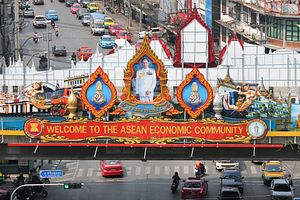Another round of ASEAN summits in Naypyidaw also means another wave of articles speculating whether ASEAN will be able to forge an ASEAN Economic Community (AEC) by 2015 – a term generally taken to imply the freer flow of goods, services, skilled labor and capital in the region.
The short answer has long been – clearly not. The quantitative metrics in the AEC scorecard, qualitative surveys by business groups, reports by notable institutions and even conversations with ASEAN elites have all told the same story for a few years now: Progress has been made over the past few years but the AEC still has a long way to go.
More importantly, though, the question itself seems rather misguided for several reasons. First, as former ASEAN Secretary General and Philippine diplomat Rodolfo Severino likes to say, the AEC is not a deadline but a process of regional integration. The original deadline for the AEC was actually in 2020, but it was subsequently moved forward to the beginning of 2015 before being pushed back to the end of that year. However, beyond these moving goalposts the critical point is that the conversation within ASEAN circles has already shifted to a “post-2015 agenda” for the AEC and other issues, reflecting a consensus among elites that there will still be a lot left to accomplish in 2016 and beyond.
Second, the yes-no dichotomy that the question lends itself to both understates what ASEAN has achieved thus far and underestimates the difficulty of what lies ahead for the AEC. The AEC scorecard suggests that the region met around 77.5 percent of its targets between 2008 and March 2013, with substantial progress made in several areas such as reducing tariffs and implementing national single windows. Over the past few years, ASEAN’s economic heft as a market with 600 million people and a combined GDP of $2.4 trillion in 2013 has also increasingly attracted foreign businesses searching for new opportunities.
The question also does not capture the formidable challenges to realizing the AEC. For example, eliminating non-tariff barriers or promoting the greater mobility of skilled workers are essential steps to realizing the AEC, but they are also ones that will be fiercely resisted by the local businesses that fear competition. In Indonesia, which represents 40 percent of the region’s economic output, there remains considerable skepticism and fear – particularly among small and medium enterprises – about an uneven playing field once the AEC comes into effect.
Third, framing the debate so narrowly around the AEC leads to a fundamental misunderstanding about how it fits into the ASEAN agenda, and why it matters for the region at large. While most of the attention is often lavished on the AEC, it is in fact only one of three pillars of the ASEAN Community vision first solidified in 2003 (the other two being the Political-Security Community and a Socio-Cultural Community). Moreover, the whole purpose of community-building, set out in a 1997 document entitled ASEAN Vision 2020, is not merely to maximize economic gains for regimes and businesses, but to establish a peaceful, stable and prosperous Southeast Asia for the region’s governments and peoples.
This is not just a technicality. As the chairman of the Malaysian chapter of the ASEAN Business Advisory Council Tan Sri Munir Majid recently suggested, ASEAN governments can only sell the painful measures required in the AEC to the common man at home if they enlist him in a broader vision that makes his life better over time. Yet today there is still an alarmingly low level of awareness about ASEAN, which largely remains an elite-driven project. Similarly, the key to sustaining external faith in ASEAN is to make outsiders aware of the big picture for the region, rather than having outsiders judge the organization by its failure to meet a deadline. Persuasion requires not only convincing results, but an appealing narrative.
This does not mean that Southeast Asian governments are off the hook when it comes to the AEC itself. A truly economically integrated ASEAN would be an even more attractive proposition for investors and multinationals, and their role will be central for governments to deliver prosperity to their people. Getting there will require Southeast Asian states to not only fulfill their commitments, but contend with conflicting domestic interests and educate their populations about the ASEAN project. That will take time, and observers ought to hold their feet to the fire. That begins with asking the right questions.
































